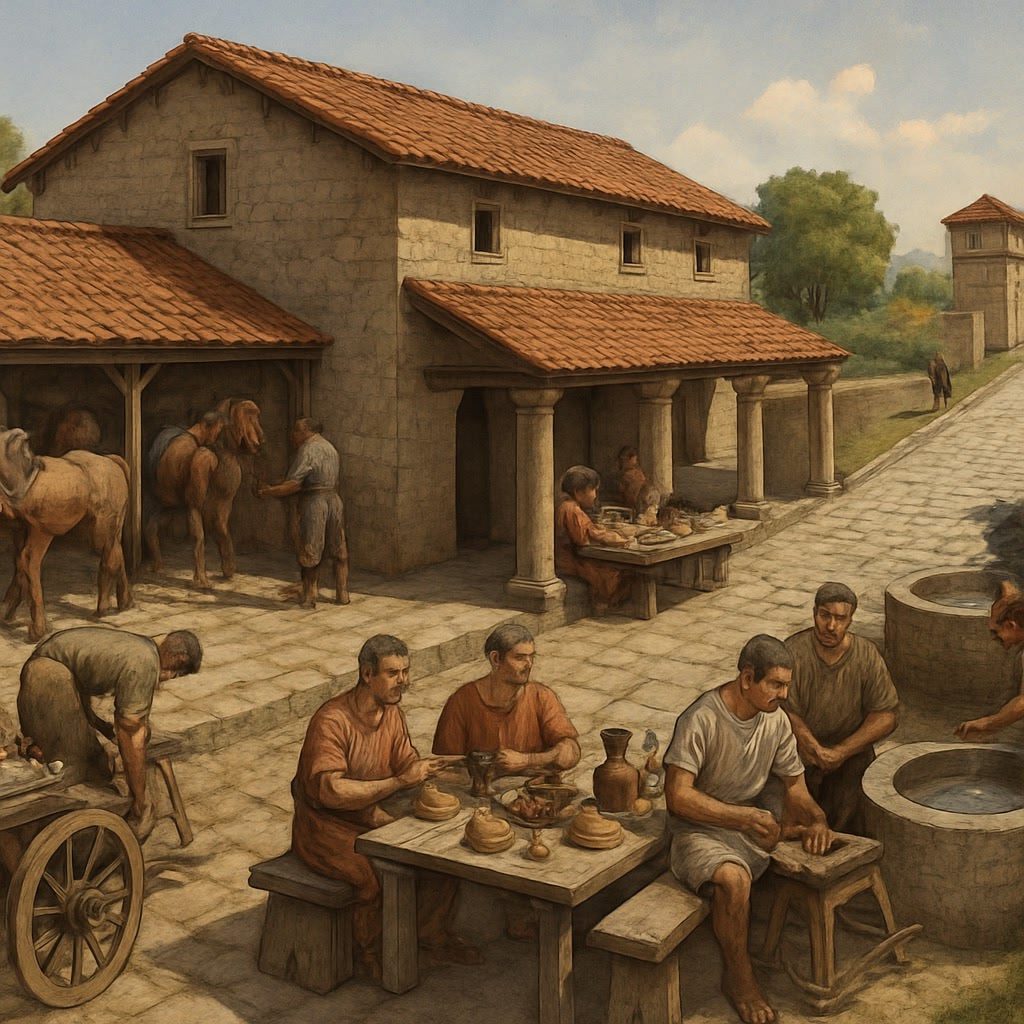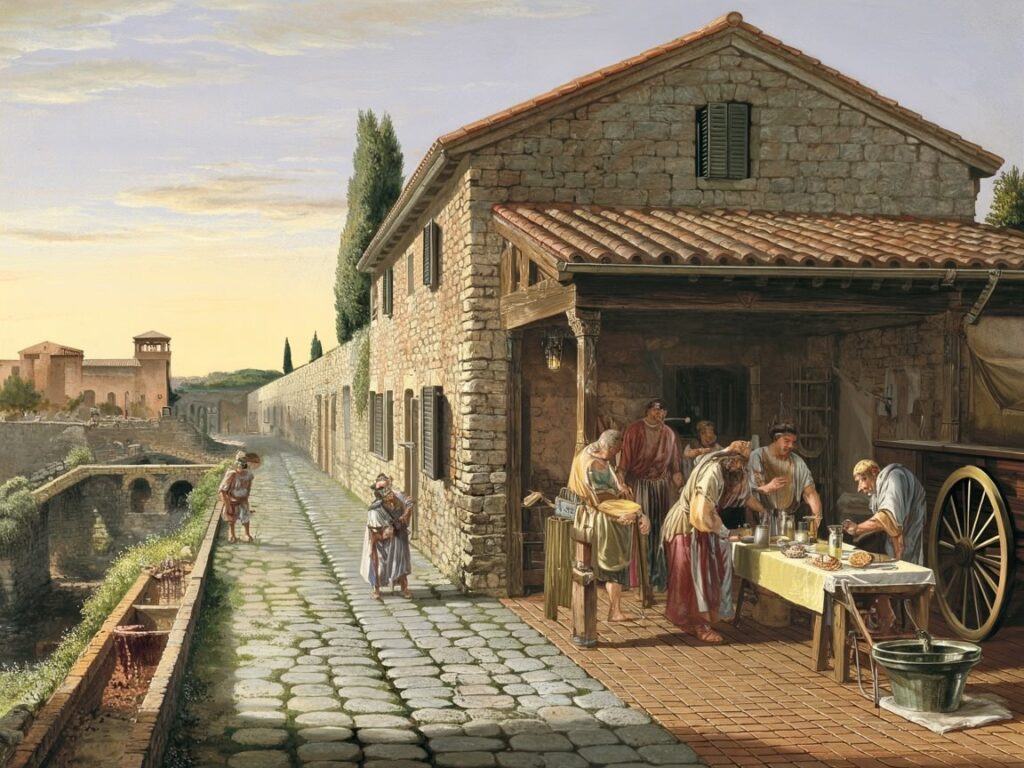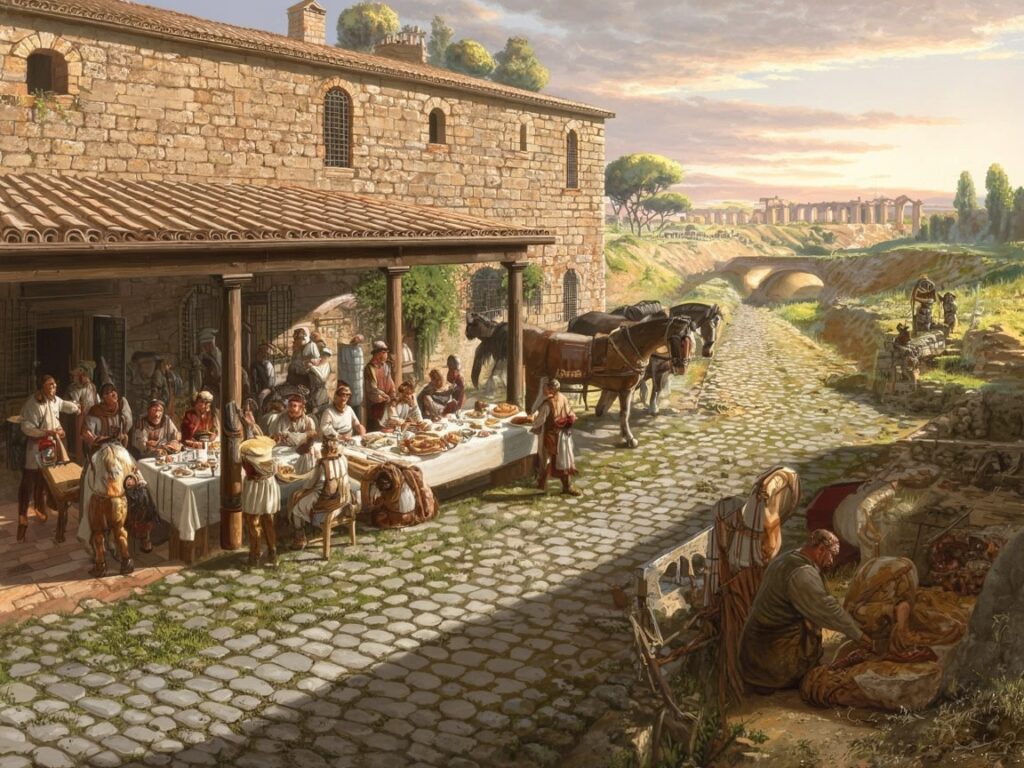The Roman roadside inns, known as mansiones, were crucial establishments in the Roman road system, especially on the famous Via Appia. These inns were not just places to rest but also served as multifunctional hubs catering to the various needs of travelers.
The Role of Roman Roadside Inns on the Via Appia
Roman roadside inns, known as mansiones, were important rest stops along the Via Appia. They were strategically located about every 20 miles and served as official way stations for travelers—whether military personnel, merchants, or ordinary citizens journeying across the empire.
Services Provided by Mansiones
Mansiones provided a variety of services for travelers:
- Lodging for people and animals: Separate accommodations existed for human guests and their horses or pack animals. Travelers could expect simple rooms to rest in after long journeys, while stables offered shelter and care for animals.
- Food and dining areas: Basic meals were available, often featuring staples like bread, olives, cheese, and wine. Communal dining spaces allowed weary travelers to eat and socialize.
- Rest and hygiene facilities: Bathing areas or wash basins gave opportunities to refresh before continuing travel.
Additional Support Offered by Mansiones
These roadside inns also acted as hubs for minor repairs—wagons could be fixed on-site—and sometimes offered guides or information about upcoming road conditions. The mansiones worked in tandem with mutationes (horse-changing stations) to maintain smooth travel logistics along the Via Appia.
By providing vital comfort and practical support, mansiones ensured that travelers faced fewer hardships on one of Rome’s most important arteries.

Travel Infrastructure of the Roman Road System: A Closer Look at the Via Appia
Engineering Marvels: The Construction of the Via Appia
Road engineering was a crucial aspect of constructing the Via Appia. Proper drainage systems were implemented to ensure the road’s longevity and usability, allowing water to flow off the surface efficiently and preventing erosion. Additionally, construction techniques focused on durability, with the innovative use of volcanic ash in concrete mixes. This volcanic ash, known as pozzolana, created a strong and long-lasting material that could withstand heavy traffic and varying weather conditions. Such feats are a testament to the remarkable ancient Roman engineering that still influences modern practices.
The Impact of Roman Roads on Trade and Communication
The efficiency of the Roman road system, particularly exemplified by well-maintained sections like the Via Appia, played a significant role in facilitating trade and communication across the vast Roman Empire. These roads connected distant provinces, enabling the swift movement of goods, troops, and information.
The straight paths of these roads, along with bridges and tunnels strategically constructed to maintain direct routes through challenging terrains, showcased the Romans’ mastery in road construction and infrastructure development.

Hazards and Security Measures on Roman Roads: A Journey Along the Via Appia
Traveling along the Via Appia was not without its dangers, as travelers faced various risks, including encounters with thieves and highwaymen. These bandits would lurk along the road, waiting to ambush unsuspecting passersby and plunder their belongings. Such threats made journeys perilous, especially for those traveling alone or without armed escorts.
The Role of Imperial Troops in Ensuring Safety
To counter these hazards, imperial troops played a crucial role in maintaining security along this vital route. Soldiers known as “stationarii” and “beneficiarii” were stationed at key points along the Via Appia to deter criminals, respond to incidents, and ensure the safety of travelers. Their presence helped safeguard trade caravans, government officials, and ordinary citizens making their way across the empire.
Historical Accounts of Troop Intervention
Historical accounts detail instances where these troops intervened to protect travelers from attacks or provided assistance in times of need. Their vigilance and swift actions helped mitigate risks posed by outlaws, making travel on the Via Appia safer and more secure for all who utilized this essential thoroughfare.
The Impact of Security Measures on Roman Transportation
By combining effective security measures with well-maintained infrastructure, the Roman authorities sought to create a reliable transportation network that promoted trade, communication, and the overall prosperity of the empire.

The Importance of Via Appia in Ancient Rome’s Military and Trade
The Via Appia played a crucial role as a military route for both the Roman Republic and later the Empire. Built in 312 B.C., it connected Rome directly to southern Italy, allowing for quick movement of legions during military operations. This strategic link helped Rome establish control over newly conquered areas and respond swiftly to rebellions or outside threats. The road’s straight and well-kept path reduced travel time, which was vital for efficiently transporting troops, supplies, and messages.
The Role of Via Appia in Trade
In addition to its military significance, the Via Appia also served as an important trade route. It facilitated commerce between Rome and the wealthy southern regions, enabling smooth transportation of goods such as grain, olive oil, wine, and other products into the capital. As a result, markets along the road thrived due to the continuous flow of merchants and produce.
Infrastructure Supporting Military and Trade Activities
To support these dual functions, a strong network of infrastructure was established to ensure safety and efficiency:
- Watchtowers positioned at intervals kept an eye out for dangers like robbers or enemy forces.
- Sturdy bridges guaranteed uninterrupted travel across rivers and challenging landscapes.
- Mansiones and mutationes served as logistical centers where travelers could rest or switch horses.
This infrastructure highlighted that the road was more than just a pathway; it was a vital lifeline crucial for both Rome’s military power and economic success.

Daily Life at Roman Roadside Inns: A Glimpse into Hospitality on the Via Appia
Roman roadside inns, or mansiones, along the Via Appia were bustling hubs of activity catering to the needs of travelers and their animals. The daily routines at these inns revolved around providing comfort and essential services in an environment designed for rest and refreshment.
Typical Activities at Roman Roadside Inns
Typical activities included:
- Meal preparation: Kitchens at mansiones prepared simple but hearty meals, often based on local staples such as bread, olives, cheese, and wine. Food was served in communal dining areas where weary travelers regrouped after long days on the road.
- Animal care: Stabling horses and other pack animals was a critical service. Inns provided secure stalls, fresh water, and fodder to ensure animals were rested and ready for the next leg of the journey.
- Lodging arrangements: Travelers found basic sleeping quarters that prioritized practicality over luxury. Beds were often simple wooden frames with straw mattresses.
- Repair services: Inns frequently housed craftsmen who could assist with wagon repairs or replace worn harnesses, preventing travel delays.
- Auxiliary support: Some mansiones offered guides familiar with surrounding routes or local conditions to help travelers navigate further destinations safely.
The Role of Hospitality in Roman Roadside Inns
Hospitality at Roman roadside inns balanced efficiency with warmth. These establishments functioned not only as resting points but also as social centers where stories were exchanged and news from distant places circulated. The care extended to both humans and animals reflected the importance of maintaining steady movement along the Via Appia, reinforcing its role as a vital artery in Roman daily life and commerce.
In addition to caring for horses and pack animals, some inns also provided services like animal therapy which could include rehabilitation for tired or injured animals. This reflects a broader understanding of animal care that extended beyond mere stabling and feeding.
Furthermore, the knowledge about caring for different types of livestock was often shared among travelers, contributing to a rich exchange of agricultural practices that benefited their farms back home.

Conclusion
Roman roadside inns along the Via Appia set a standard for comfort for travelers and crucial logistical support. These mansiones were more than mere waypoints; they formed an essential network that sustained military campaigns, trade, and daily travel across the empire. The blend of hospitality services, safety measures, and well-engineered infrastructure created a reliable system that influenced future travel and lodging concepts.
Key takeaways:
- Inns provided rest, food, and care for both people and animals
- Integration with security patrols ensured safer journeys
- Infrastructure supported efficient movement of goods and troops
Roman Roadside Inns: Hospitality, Travel Hazards, and Daily Life on the Via Appia remain a testament to Roman innovation in travel logistics.

FAQs (Frequently Asked Questions)
What were Roman roadside inns and what role did they play on the Via Appia?
Roman roadside inns, known as mansiones, served as essential lodging facilities along the Via Appia, providing travelers and their animals with rest, food, and various services. They functioned as vital hubs of hospitality and logistical support for those journeying through this important Roman road.
How was the Via Appia constructed to ensure durability and efficiency in the Roman road system?
The Via Appia was engineered using advanced construction techniques such as incorporating volcanic ash into concrete mixes for enhanced durability. Proper drainage systems were implemented to maintain road integrity, making it one of the most efficient and well-maintained routes that facilitated trade and communication throughout the Roman Empire.
What types of hazards did travelers face on the Via Appia and how was security maintained?
Travelers on the Via Appia encountered risks including attacks from thieves and highwaymen. To mitigate these dangers, imperial troops were stationed along the route to maintain security, supported by infrastructure such as watchtowers, ensuring safer passage for military and commercial activities.
In what ways did the Via Appia contribute to Ancient Rome’s military and commercial landscape?
The Via Appia served as a critical military artery connecting Rome with southern Italy, enabling swift movement of troops during expeditions. Additionally, it functioned as a major commercial route facilitating trade, supported by robust infrastructure like bridges and roadside inns that enhanced logistical operations.
What daily life activities and services were typical at Roman roadside inns along the Via Appia?
Daily routines at mansiones included preparing meals for weary travelers, offering lodging accommodations for humans and animals, stabling horses, and providing guides for onward journeys. These services exemplified Roman hospitality and catered to the diverse needs of those traveling this busy thoroughfare.
What is the legacy of Roman roadside inns along the Via Appia in terms of traveler comfort and logistical support?
Roman roadside inns along the Via Appia left a lasting legacy by providing comfort through well-organized hospitality services and crucial logistical support. They played a significant role in sustaining long-distance travel within the empire, contributing to economic prosperity and cultural exchange across regions connected by this historic route.

